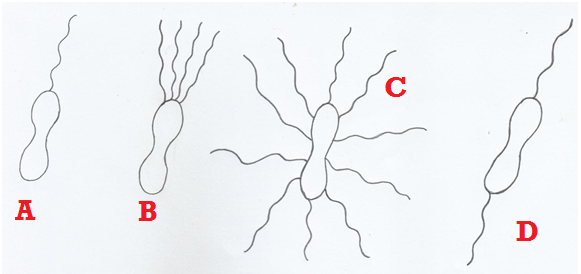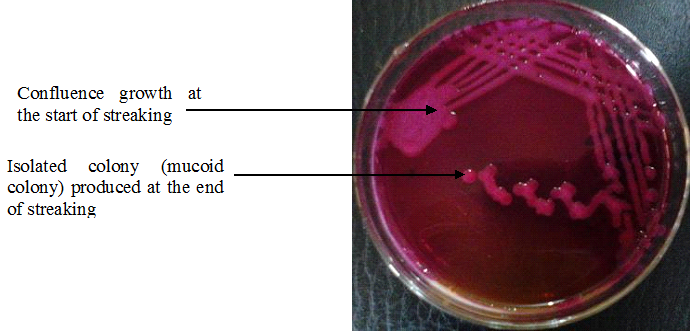Flagella (singular: flagellum) are the organelles of locomotion or movement in prokaryotic cells. Microbial motility is a key feature for motile bacteria, and this characteristic allows organisms to move from one location to another in search of food or away from potential attacks in their normal habitat.
Flagella are thread-like slender-looking and rigid structures that extend from the cell wall of bacteria. They are composed of protein molecules known as flagellin. Flagella is found in both Gram-positive and Gram-negative bacteria but only those organisms that are motile possess them, and they play critical role in bacteria identification in the laboratory.
Bacterial flagellation is of various types; and these are:
- Monotrichous flagellation: This type of flagellation is normally seen Pseudomonas species and Vibrio species. In monotrichous flagellation, bacteria have a single flagellum, and the flagellum is normally located or formed at one end of the bacterial cell (Figure 1).Monotrichous flagellation can also be called polar flagellation because the flagellum is attached at one end of the bacterium.
- Lophotrichous flagellation: In lophotrichous flagellation, bacteria have a bunch or cluster of flagella at one end of or both ends of the microbial cell. This type of flagellation is seen in Spirillum species and Spirochaetes. Lophotrichous flagellation is characterized by multiple polar flagella i.e. assemblage of flagella at one or both ends of a bacterium (Figure 1).

- Peritrichous flagellation: Peritrichous flagellation is a type of flagellation in which a bacterium has flagella scattered all over the entire surface of the organism (Figure 1). Bacteria with this type of flagellation have flagellum inserted or placed at many points around the cell surface; and peritrichous flagellation makes bacteria to resemble swarming cells. Peritrichous flagellation is found in Rhodospirillum species and Proteus species.
- Amphitrichous flagellation: Amphitrichous flagellation is a type of flagellation in which bacteria have a single flagellum at each end of the microbial cell.
References
Alberts B, Bray D, Lewis J, Raff M, Roberts K and Watson J.D (2002). The molecular Biology of the Cell. Fourth edition. New York, Garland, USA.
Berg JM, Tymoczko JL, Stryer L (2002). Biochemistry (5th ed.). New York, NY: W. H. Freeman.
Brooks G.F., Butel J.S and Morse S.A (2004). Medical Microbiology, 23rd edition. McGraw Hill Publishers. USA.
Campbell, Neil A.; Brad Williamson; Robin J. Heyden (2006). Biology: Exploring Life. Boston, Massachusetts: Pearson Prentice Hall.
Cooper G.M and Hausman R.E (2004). The cell: A Molecular Approach. Third edition. ASM Press.
Dale J (2003). Molecular genetics of bacteria. Jeremy W. Dale and Simon Park (4th eds.). John Wiley & Sons Ltd, West Sussex, UK. Pp.
Karp, Gerald (2009). Cell and Molecular Biology: Concepts and Experiments. John Wiley & Sons.
Lodish H, Berk A, Matsudaira P, Kaiser C.A, Kreiger M, Scott M.P, Zipursky S.L and Darnell J (2004). Molecular Cell Biology. Fifth edition. Scientific American Books, Freeman, New York, USA.
Madigan M.T., Martinko J.M., Dunlap P.V and Clark D.P (2009). Brock Biology of microorganisms. 12th edition. Pearson Benjamin Cummings Publishers. USA. Pp.795-796.
Maton, Anthea (1997). Cells Building Blocks of Life. New Jersey: Prentice Hall.
Discover more from #1 Microbiology Resource Hub
Subscribe to get the latest posts to your email.


